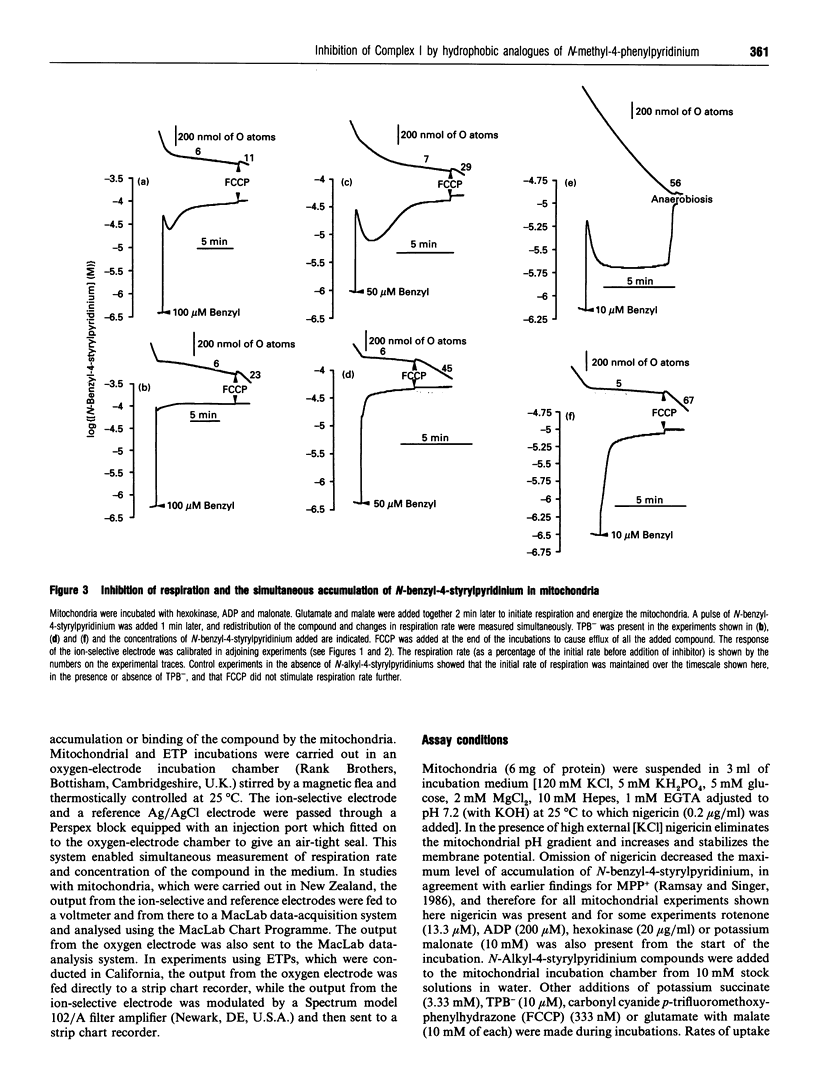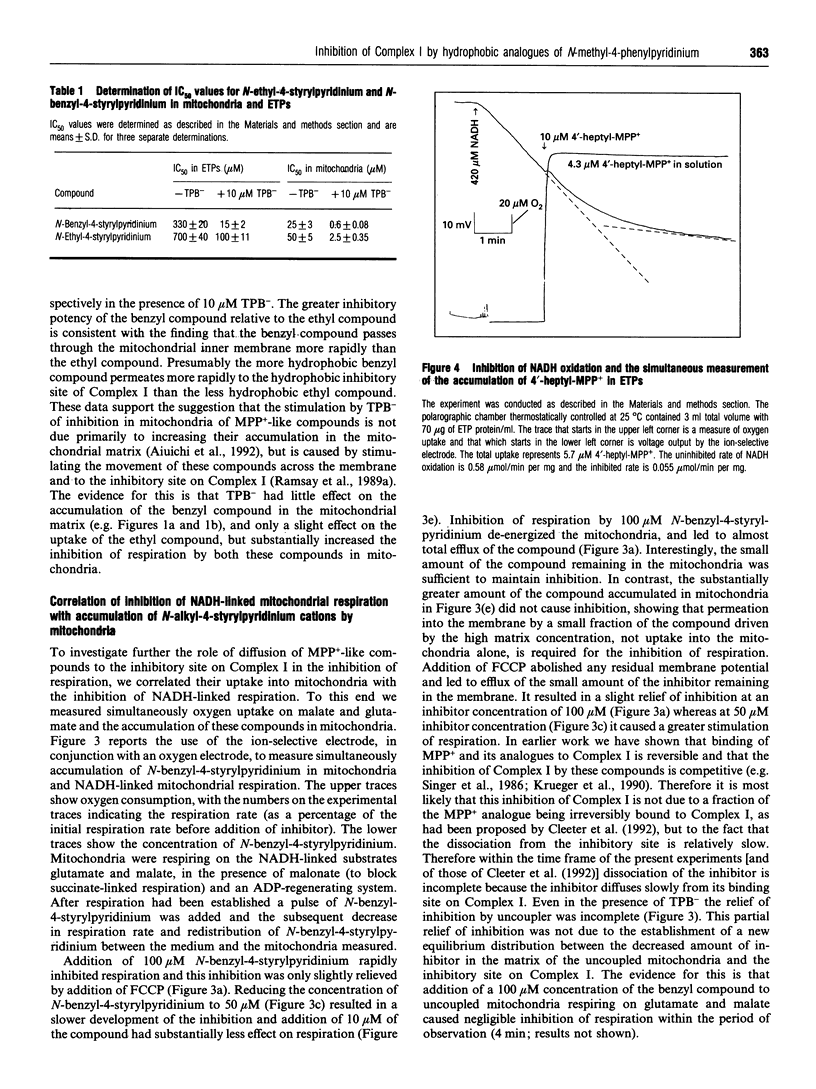Abstract
N-methyl-4-phenylpyridinium (MPP+), the neurotoxic metabolite of N-methyl-4-phenyl-1,2,3,6-tetrahydropyridine, kills dopaminergic neurons after its accumulation in mitochondria where it inhibits Complex I of the respiratory chain. MPP+ inhibits respiration by binding to both a hydrophobic and a hydrophilic site on Complex I and this inhibition is increased by the lipophilic tetraphenylboron anion (TPB-) which facilitates movement of MPP+ through membranes and its penetration to the hydrophobic binding site on Complex I. To investigate the inhibition of respiration by MPP(+)-like compounds, we have measured simultaneously NADH-linked mitochondrial respiration and the uptake and accumulation of the N-benzyl-4-styrylpyridinium and N-ethyl-4-styrylpyridinium cations in mitochondria using ion-selective electrodes. The data provide direct evidence that TPB- increases the inhibition not by increasing matrix concentration but by facilitating access to the inhibitory sites on Complex I. We have also compared the rates of uptake of MPP+ analogues of varied lipophilicity by the inner membrane and the development of inhibition of NADH oxidation, using an inverted mitochondrial inner membrane preparation and appropriate ion-selective electrodes. These experiments demonstrated that the amount of MPP+ analogue bound to the inner membrane greatly exceeded the quantity required for complete inhibition of NADH oxidation. Moreover, binding to the membrane occurred much more rapidly than the development of inhibition with all MPP+ analogues tested. This suggests that the attainment of a correct orientation of these compounds within the membrane and the binding site may be a rate-limiting step in the development of inhibition.
Full text
PDF






Selected References
These references are in PubMed. This may not be the complete list of references from this article.
- Aiuchi T., Syou M., Matsunaga M., Kinemuchi H., Nakaya K., Nakamura Y. Enhancement of the uptake of 1-methyl-4-phenylpyridinium ion (MPP+) in mitochondria by tetraphenylboron. Biochim Biophys Acta. 1992 Jan 31;1103(2):233–238. doi: 10.1016/0005-2736(92)90092-z. [DOI] [PubMed] [Google Scholar]
- CRANE F. L., GLENN J. L., GREEN D. E. Studies on the electron transfer system. IV. The electron transfer particle. Biochim Biophys Acta. 1956 Dec;22(3):475–487. doi: 10.1016/0006-3002(56)90058-0. [DOI] [PubMed] [Google Scholar]
- CREMONA T., KEARNEY E. B. STUDIES ON THE RESPIRATORY CHAIN-LINKED REDUCED NICOTINAMIDE ADENINE DINUCLEOTIDE DEHYDROGENASE. VI. FURTHER PURIFICATION AND PROPERTIES OF THE ENZYME FROM BEEF HEART. J Biol Chem. 1964 Jul;239:2328–2334. [PubMed] [Google Scholar]
- Chiba K., Trevor A., Castagnoli N., Jr Metabolism of the neurotoxic tertiary amine, MPTP, by brain monoamine oxidase. Biochem Biophys Res Commun. 1984 Apr 30;120(2):574–578. doi: 10.1016/0006-291x(84)91293-2. [DOI] [PubMed] [Google Scholar]
- Cleeter M. W., Cooper J. M., Schapira A. H. Irreversible inhibition of mitochondrial complex I by 1-methyl-4-phenylpyridinium: evidence for free radical involvement. J Neurochem. 1992 Feb;58(2):786–789. doi: 10.1111/j.1471-4159.1992.tb09789.x. [DOI] [PubMed] [Google Scholar]
- Davey G. P., Tipton K. F., Murphy M. P. Uptake and accumulation of 1-methyl-4-phenylpyridinium by rat liver mitochondria measured using an ion-selective electrode. Biochem J. 1992 Dec 1;288(Pt 2):439–443. doi: 10.1042/bj2880439. [DOI] [PMC free article] [PubMed] [Google Scholar]
- Davey G. P., Tipton K. F., Murphy M. P. Use of an electrode selective for 1-methyl-4-phenylpyridinium (MPP+) to measure its uptake and accumulation by mitochondria. J Neural Transm Suppl. 1993;40:47–55. [PubMed] [Google Scholar]
- Gluck M. R., Krueger M. J., Ramsay R. R., Sablin S. O., Singer T. P., Nicklas W. J. Characterization of the inhibitory mechanism of 1-methyl-4-phenylpyridinium and 4-phenylpyridine analogs in inner membrane preparations. J Biol Chem. 1994 Feb 4;269(5):3167–3174. [PubMed] [Google Scholar]
- Gluck M. R., Youngster S. K., Ramsay R. R., Singer T. P., Nicklas W. J. Studies on the characterization of the inhibitory mechanism of 4'-alkylated 1-methyl-4-phenylpyridinium and phenylpyridine analogues in mitochondria and electron transport particles. J Neurochem. 1994 Aug;63(2):655–661. doi: 10.1046/j.1471-4159.1994.63020655.x. [DOI] [PubMed] [Google Scholar]
- Heikkila R. E., Hwang J., Ofori S., Geller H. M., Nicklas W. J. Potentiation by the tetraphenylboron anion of the effects of 1-methyl-4-phenyl-1,2,3,6-tetrahydropyridine and its pyridinium metabolite. J Neurochem. 1990 Mar;54(3):743–750. doi: 10.1111/j.1471-4159.1990.tb02314.x. [DOI] [PubMed] [Google Scholar]
- Hoppel C. L., Grinblatt D., Kwok H. C., Arora P. K., Singh M. P., Sayre L. M., Greenblatt D. Inhibition of mitochondrial respiration by analogs of 4-phenylpyridine and 1-methyl-4-phenylpyridinium cation (MPP+), the neurotoxic metabolite of MPTP. Biochem Biophys Res Commun. 1987 Oct 29;148(2):684–693. doi: 10.1016/0006-291x(87)90931-4. [DOI] [PubMed] [Google Scholar]
- Horgan D. J., Ohno H., Singer T. P. Studies on the respiratory chain-linked reduced nicotinamide adenine dinucleotide dehydrogenase. XV. Interactions of piericidin with the mitochondrial respiratory chain. J Biol Chem. 1968 Nov 25;243(22):5967–5976. [PubMed] [Google Scholar]
- Javitch J. A., D'Amato R. J., Strittmatter S. M., Snyder S. H. Parkinsonism-inducing neurotoxin, N-methyl-4-phenyl-1,2,3,6 -tetrahydropyridine: uptake of the metabolite N-methyl-4-phenylpyridine by dopamine neurons explains selective toxicity. Proc Natl Acad Sci U S A. 1985 Apr;82(7):2173–2177. doi: 10.1073/pnas.82.7.2173. [DOI] [PMC free article] [PubMed] [Google Scholar]
- Krueger M. J., Sablin S. O., Ramsay R., Singer T. P. Reactivation of NADH dehydrogenase (complex I) inhibited by 1-methyl-4-(4'-alkylphenyl)pyridinium analogues: a clue to the nature of the inhibition site. J Neurochem. 1993 Oct;61(4):1546–1548. doi: 10.1111/j.1471-4159.1993.tb13653.x. [DOI] [PubMed] [Google Scholar]
- Krueger M. J., Singer T. P., Casida J. E., Ramsay R. R. Evidence that the blockade of mitochondrial respiration by the neurotoxin 1-methyl-4-phenylpyridinium (MPP+) involves binding at the same site as the respiratory inhibitor, rotenone. Biochem Biophys Res Commun. 1990 May 31;169(1):123–128. doi: 10.1016/0006-291x(90)91442-u. [DOI] [PubMed] [Google Scholar]
- Nicklas W. J., Vyas I., Heikkila R. E. Inhibition of NADH-linked oxidation in brain mitochondria by 1-methyl-4-phenyl-pyridine, a metabolite of the neurotoxin, 1-methyl-4-phenyl-1,2,5,6-tetrahydropyridine. Life Sci. 1985 Jul 1;36(26):2503–2508. doi: 10.1016/0024-3205(85)90146-8. [DOI] [PubMed] [Google Scholar]
- Ramsay R. R., Krueger M. J., Youngster S. K., Gluck M. R., Casida J. E., Singer T. P. Interaction of 1-methyl-4-phenylpyridinium ion (MPP+) and its analogs with the rotenone/piericidin binding site of NADH dehydrogenase. J Neurochem. 1991 Apr;56(4):1184–1190. doi: 10.1111/j.1471-4159.1991.tb11409.x. [DOI] [PubMed] [Google Scholar]
- Ramsay R. R., Mehlhorn R. J., Singer T. P. Enhancement by tetraphenylboron of the interaction of the 1-methyl-4-phenylpyridinium ion (MPP+) with mitochondria. Biochem Biophys Res Commun. 1989 Mar 31;159(3):983–990. doi: 10.1016/0006-291x(89)92205-5. [DOI] [PubMed] [Google Scholar]
- Ramsay R. R., Salach J. I., Singer T. P. Uptake of the neurotoxin 1-methyl-4-phenylpyridine (MPP+) by mitochondria and its relation to the inhibition of the mitochondrial oxidation of NAD+-linked substrates by MPP+. Biochem Biophys Res Commun. 1986 Jan 29;134(2):743–748. doi: 10.1016/s0006-291x(86)80483-1. [DOI] [PubMed] [Google Scholar]
- Ramsay R. R., Singer T. P. Energy-dependent uptake of N-methyl-4-phenylpyridinium, the neurotoxic metabolite of 1-methyl-4-phenyl-1,2,3,6-tetrahydropyridine, by mitochondria. J Biol Chem. 1986 Jun 15;261(17):7585–7587. [PubMed] [Google Scholar]
- Ramsay R. R., Youngster S. K., Nicklas W. J., McKeown K. A., Jin Y. Z., Heikkila R. E., Singer T. P. Structural dependence of the inhibition of mitochondrial respiration and of NADH oxidase by 1-methyl-4-phenylpyridinium (MPP+) analogs and their energized accumulation by mitochondria. Proc Natl Acad Sci U S A. 1989 Dec;86(23):9168–9172. doi: 10.1073/pnas.86.23.9168. [DOI] [PMC free article] [PubMed] [Google Scholar]
- Salach J. I., Singer T. P., Castagnoli N., Jr, Trevor A. Oxidation of the neurotoxic amine 1-methyl-4-phenyl-1,2,3,6-tetrahydropyridine (MPTP) by monoamine oxidases A and B and suicide inactivation of the enzymes by MPTP. Biochem Biophys Res Commun. 1984 Dec 14;125(2):831–835. doi: 10.1016/0006-291x(84)90614-4. [DOI] [PubMed] [Google Scholar]
- Singer T. P., Salach J. I., Castagnoli N., Jr, Trevor A. Interactions of the neurotoxic amine 1-methyl-4-phenyl-1,2,3,6-tetrahydropyridine with monoamine oxidases. Biochem J. 1986 May 1;235(3):785–789. doi: 10.1042/bj2350785. [DOI] [PMC free article] [PubMed] [Google Scholar]
- Tipton K. F., Singer T. P. Advances in our understanding of the mechanisms of the neurotoxicity of MPTP and related compounds. J Neurochem. 1993 Oct;61(4):1191–1206. doi: 10.1111/j.1471-4159.1993.tb13610.x. [DOI] [PubMed] [Google Scholar]
- Youngster S. K., Gluck M. R., Heikkila R. E., Nicklas W. J. 4'-alkylated analogs of 1-methyl-4-phenylpyridinium ion are potent inhibitors of mitochondrial respiration. Biochem Biophys Res Commun. 1990 Jun 15;169(2):758–764. doi: 10.1016/0006-291x(90)90396-5. [DOI] [PubMed] [Google Scholar]


